The first ship loaded with 38,500 tonnes of coal bound for China has left VaninoTransUgol terminal in the Muchke Bay (Khabarovsk Territory), says press center of the company.
On 21 June 2020, the Oriental Pearl bulker with deadweight of 45,500 tonnes moored at the terminal of VaninoTransUgol JSC for a loading test of port equipment.
It took several days to load the ship with coal concentrate.
The waterfront facilities of the coal terminal can accommodate ships of up to 247 meters in length, up to 40.8 meters in width and up to 15.25 meters in draft. The tests included starting-up and adjustment of conveyor systems, railcar dumper, systems of automation, dust suppression and aspiration that ensure prevention of negative impact on the environment.
The loading of the second ship of 42,500 DWT was commenced on July 2.
The dedicated coal terminal in the Muchke Bay (Khabarovsk Territory) including the federal property (underwater HESs and navigation safety facilities) is being constructed under the federal project “Sea Ports of Russia”, transport section of the comprehensive plan for upgrading and expanding core infrastructure till 2024.
The first phase of the terminal scheduled for commissioning in 2020 has annual throughput capacity of 12 million tonnes. The second phase foresees its expansion to 24 million tonnes by 2023.
The terminal of VaninoTransUgol (a company of the Kolmar GC) is primarily intended for handling of high quality coking coals mined in the South Yakutia by the Denisovsky and the Inaglinsky MPC as well as other coal mining enterprises. The company’s own terminal in the Khabarovsk Territory will let it considerably cut expenses for railway and sea transportation while ensuring supplies of proper quality and on scheduled time.
The project on construction of a modern coal terminal is in line with the development of Kolmar group’s production and logistic facilities including mining, processing, transportation and transshipment of mineral resources with their further export to the APR countries.
Glavgosexpertiza approves expansion of access canal to Sabetta port
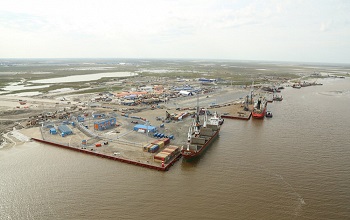 Glavgosexpertiza (Russia's Main Department of State Expertise) says it has considered the design documentation for reconstruction of the access canal to the port of Sabetta aimed to ensure safe shipping and approved expansion of the transit passage in 2020-2030.
Glavgosexpertiza (Russia's Main Department of State Expertise) says it has considered the design documentation for reconstruction of the access canal to the port of Sabetta aimed to ensure safe shipping and approved expansion of the transit passage in 2020-2030.
The access canal to the port of Sabetta was built and put into operation in 2019 to ensure year-round movements of ships and shipment of liquefied natural gas and liquefied gas condensate.
The project documentation foresees expansion of the canal to meet the demand of NOVATEK and Gazprom Neft for shipments of hydrocarbons.
Besides, the expanded canal can be used for the delivery of gravity-based structures to NOVATEK’s Utrenny terminal being built in the Gulf of Ob under the Arctic LNG 2 project.
The reconstruction project is to be implemented in two phases. The first one (2020-2021) foresees the expansion of the canal to 475 meters at its straight section and to 573 meters at the turn.
Upon completion of the second phase of dredging scheduled for 2022, the width will be increased to 573 meters along the entire canal. Besides, aids to navigation will be moved on the canal.
“Currently, the canal can ensure up to four ship passages per day while its capacity upon completion of the expansion will be raised to nine passages per day, that is at least 1,500 passages per year”, says Glavgosexpertiza.
The reconstruction project has been developed by LENMORNIIPROEKT JSC with FSUE Hydrographic Company to conduct the reconstruction works.
It was Krylov State Research Center that conducted scientific substantiation of the parameters for modernization of the canal in the Gulf of Ob to ensure safety while increasing the traffic of vessels.
Krylov State Research Center also conducts modelling of offshore operations on delivery and installation of large structures at the Utrenny terminal for LNG shipments.
Russia resumes construction of cruise ships
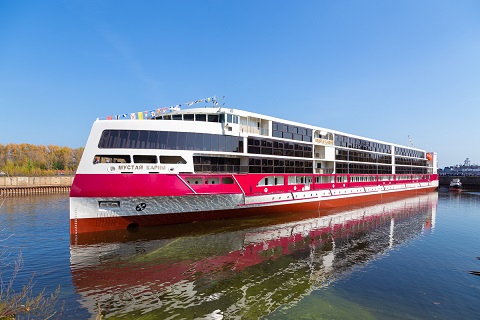 Amid the drastic fall of the cruise market caused by the COVID19 pandemic, a passenger ship built for the first time in a 60-year period has been delivered in Russia. Nizhny Novgorod based shipyard of United Shipbuilding Corporation (USC) has built a cruise ship named Mustay Karim for Vodohod, Russia’s largest operator of passenger ships.
Amid the drastic fall of the cruise market caused by the COVID19 pandemic, a passenger ship built for the first time in a 60-year period has been delivered in Russia. Nizhny Novgorod based shipyard of United Shipbuilding Corporation (USC) has built a cruise ship named Mustay Karim for Vodohod, Russia’s largest operator of passenger ships.
The construction of the vessel named after the soviet poet, writer and playwright of Bashkiria was commenced in 2017 under the tripartite contract between the Nizhny Novgorod based manufacturer, captive leasing company Mashpromleasing acting as a customer and Vodohod company which receives the ship.
The four-deck cruise liner of Project PV300 designed by Marine Engineering Bureau can accommodate 329 passengers in comfortable two-person cabins of 17 to 46 square meters.
In the navigation season of 2020, the ship will be deployed for operation on Moscow - St. Petersburg, Moscow - Astrakhan and Moscow - Rostov-on-Don lines, in the Sea of Azov and in the Black Sea.
The ship features “all the attributes of a five-star hotel” including its supporting infrastructure. The restaurant on the main deck is of 329 seats, so it is able to accommodate all the passengers including children. For leisure time, there are round-view salons, a transforming conference hall, three bars, a children's room, a fitness center and a solarium on the open sun deck.
USC is building another vessel of Project PV300VD for 300 passengers. The USC management expects the Peotr Veliky cruise ship to be ready for the navigation season of 2021. The liner was laid down at the Astrakhan Region based Lotos shipyard in August 2016 with the construction kicked off by Russian President Vladimir Putin.
Construction of new icebreaker for Rosmorport completed in Saint-Petersburg
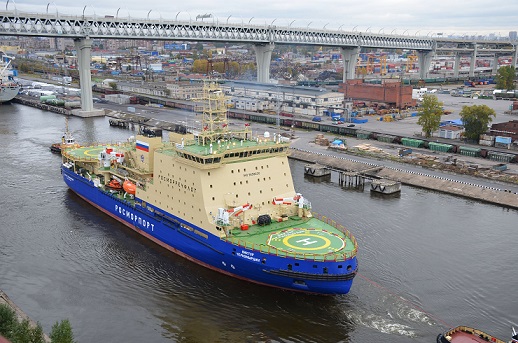 The Viktor Chernomyrdin is the most powerful diesel-electric icebreaker in Russia
The Viktor Chernomyrdin is the most powerful diesel-electric icebreaker in Russia
LK-25 icebreaker Viktor Chernomyrdin has been built by Baltiysky Zavod shipyard of United Shipbuilding Corporation (USC) under the order of FSUE Rosmorport. The delivery to the customer was postponed from the end of 2019 to the first quarter of 2020. According to USC President Aleksey Rakhmanov, the cost of the icebreaker has increased due to considerable modification of the design.
In November 2018, a fire broke out on board the icebreaker under construction covering about 300 square metres and injuring one person. USC estimated the damage at RUB 150 million.
The Viktor Chernomyrdin icebreaker is one of the most powerful diesel-electric icebreakers in the world. The ship of 22,300 tonnes in displacement can sail with a speed of about 17 knots in clear water and break through ice of up to 3 meters thick with a 20-centimetre snow cover at 2 knots in both ahead and astern directions. The icebreaker features high maneuverability. The vessel is also fitted with an air-bubbling system that reduces friction between the hull and ice. The ship’s crew – 38. Endurance - 61 days.
The vessel is intended for icebreaking assistance and towing of ships. With its special premises and laboratories for scientific equipment as well as ability to accommodate 90 special personnel it can service scientific expeditions in the Arctic and Antarctic. The icebreaker can also serve as a fire-fighting vessel.
25 MW icebreaker of Project 22600, named Viktor Chernomyrdin, was laid down by Baltiysky Zavod-Sudostroyeniye LLC on 10 October 2012 and launched by Baltiysky Zavod in Saint-Petersburg on 30 December 2016.
Lead chemical tanker PortNews is under construction for Volgotrans
The chemical tanker PortNews is building by Astrakhan Shipbuilding Production Association (ASPO, a company of USC) for Volgotrans under the leasing programme of Mashpromleasing.
The main hull construction works are nearing completion with pipe assembling and outfitting underway. The boiler unit is to be placed onto the ship by the end of the week with the same works on the second ship scheduled for February. In the nearest future, the shipbuilders will commence cable tightening and cabin construction.
Vessels of Project 00216–Ь (sea/river class) are intended for transportation of crude oil and oil products as well as a wide range of liquid cargoes - noxious liquid substances including those requiring heating to 60 degrees). Such ships can simultaneously carry three types of cargo.
Chemical tankers of Project 00216–Ь have the following characteristics: length – 141 m; width – 16,7 m; depth – 6 m; endurance – 15 days; speed – about 10 knots; river deadweight (with draft of 3.6 m) — 5,350 t, sea deadweight (with draft of 4.6 m) — 7,900 t; crew – 13.
The naming ceremony for the lead chemical tanker of Project 00216–Ь was held in the framework of the Neva-2019 exhibition in Saint Petersburg. The tanker was named after information and analytical agency PortNews (IAA PortNews).
ASPO, construction division of Caspian Energy Group specializes in construction of technical facilities for offshore field development and commercial shipbuilding. ASPO comprises Astrakhan based shipyards: ASPO Main Yard, ASPO Site вДЦ3 and Lotos shipyard.
Shipping company Volgotrans (Samara, member of Russian Chamber of Shipping) earlier signed an agreement with United Shipbuilding Corporation (USC) for construction of more than 30 sea/river tankers of 6,000-7,500 DWT within three years, The ships will be built to Russian designs and will sail under the flag of Russia. The orders will be placed at both USC and non-USC shipyards. All state support measures will be used to finance the project: subsidized leasing, utilization grant and Government Decree No 383 on refunding of loan interest rates.
Information & Analytical Agency PortNews (IAA PortNews) was created and registered as a Russian media outlet in 2004. Today IAA PortNews is a leading and widely read source of maritime and river transport news, and a channel of interactions of businesses, government and the media. The Agency’s major project is the news portal (www.portnews.ru) providing online daily coverage of important events in the port sector for the Russian and foreign readers. The news resource provides real-time updates and is accessible free of charge.
Okskaya Shipyard launches third dry cargo ship of Project RSD59 built for Petrotrans
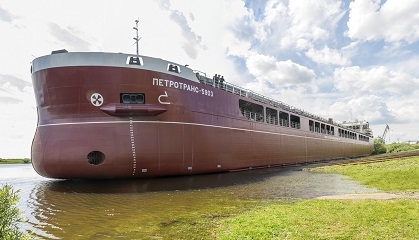 The third multipurpose dry cargo vessel of Project RSD59 built for Petrotrans, Petrotrans - 5903, was launched on 10 June 2020, says Marine Engineering Bureau, the RSD59 series designer.
The third multipurpose dry cargo vessel of Project RSD59 built for Petrotrans, Petrotrans - 5903, was launched on 10 June 2020, says Marine Engineering Bureau, the RSD59 series designer.
The ship was ordered by the State Leasing Transport Company (SLTC) for Petrotrans as a lessee.
The construction of 15 vessels of RSD59 series is underway at Okskaya Shipyard. The first five will be delivered to Petrotrans and the next ten – to Astrol.
The RSD59 series vessels are being built to Volgo-Don Max class and have the maximum possible dimensions to transit the Volga-Don Canal.
The RSD59 series vessels were designed for transportation of break bulk, bulk, container, timber, grain and oversize cargo, dangerous goods (Classes 1.4S, 2, 3, 4, 5, 6.1, 8, 9 IMDG Code and BC Code’s Appendix B in the Caspian Sea, in the Mediterranean, Black, Baltic, White, North Seas, including sailings around Europe and to the Irish Sea in winter season.
The new series is a successor of RSD49 design which had three holds. RSD59 ships with extra full hull forms have a unique second hold, the largest among Volgo-Don Max ships.
The vessel’s class notation is –Ъ–Ь Ice2(hull; power) R2 –РUT1-ICS BWM(T) CONT (deck, cargo holds Nos.1,2) DG (bulk, pack) of the Russian Maritime Register of Shipping which meets all the requirements of international conventions in force at the time of the vessel's laying.
Deadweight in the sea with draft of 4.706 m – 8,144 t; Deadweight in river with draft of 3.60 m – 5,320 t. The maximum length is 141.0 m, the overall width is 16.98 m, depth is 6.00 m. The capacity of cargo holds is 11,400 cubic meters. The operating speed is 10.5 knots. Endurance in sea - 20 days. Crew - 11, berths - 14. There is a sanitary cabin and a pilot cabin.
The lead ship of Project RSD59 was laid down at Okskaya Shipyard on 30 July 2019 and delivered to Petrotrans on 29 May 2020, the second ship was laid down on 27 September 2019 and launched on 21 April 2020, the third ship was laid down on 30 October 2019, the forth – on 29 November 2019, the fifth – on 27 December 2019, the sixth – on 28 January 2020.
Sovcomflot successfully uses LNG as the main fuel for large tankers
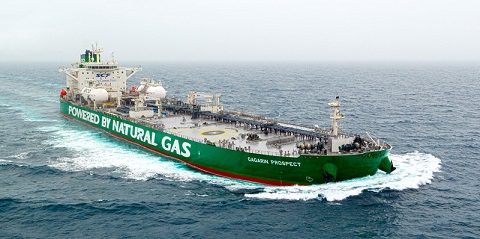 When speaking at the 3rd “LNG Fleet and LNG Bunkering in Russia” conference organized by PortNews Media Group with the assistance of RF Ministry of Industry and Trade and Russian Chamber of Shipping, Sovcomflot CEO Igor Tonkovidov shared the company’s successful experience in introduction of LNG as a primary fuel for large-capacity tankers, Sovcomflot says in a press release.
When speaking at the 3rd “LNG Fleet and LNG Bunkering in Russia” conference organized by PortNews Media Group with the assistance of RF Ministry of Industry and Trade and Russian Chamber of Shipping, Sovcomflot CEO Igor Tonkovidov shared the company’s successful experience in introduction of LNG as a primary fuel for large-capacity tankers, Sovcomflot says in a press release.
Igor Tonkovidov said that the SCF fleet currently numbers six tankers powered by gas. “During the summer navigation season of 2019, our vessels successfully completed commercial voyages along the NSR lanes running on LNG fuel throughout the entire route. While in passage, the tests were performed to check the operation of systems and mechanisms in low temperature conditions and a new deep-water route was tried in the northern part of the East Siberian Sea. The company has demonstrated its commitment to the use of a cleaner-burning fuel in the Arctic”, said Igor Tonkovidov.
“LNG as a marine fuel in sulphur emission control areas of the North and Baltic Seas is more economically efficient compared to diesel fuel. Operation of large-capacity tankers fueled by gas for more than a year shows that using LNG ensures a 30-pct reduction of CO2 emissions compared with similar vessels powered by traditional heavy fuel. Russia has extensive reserves of natural gas and that is our sound competitive advantage”, emphasized Sovcomflot CEO.
According to Sovcomflot CEO, the Ministry of Transport of the Russian Federation and the Federal Marine and River Transport Agency (Rosmorrechflot) have undertaken a number of successive steps to encourage using LNG as a more environmentally friendly fuel. In particular, the ports of the Baltic Basin have reduced port dues for vessels running in gas fuel. Gazpromneft Marine Bunker is currently implementing a project on construction of Russia’s first LNG bunkering tanker intended for the Baltic Sea. In June 2019, Sovcomflot and Gazpromneft Marine Bunker signed an agreement on cooperation in implementation of projects on bunkering of ships with gas fuel.
Other Sovcomflot representatives, Roman Porkromkin, Deputy Head, Unit of Technical Policy and Shipbuilding, and Mikhail Kovalskii, Director, Training Center "Sovcomflot", also spoke at the conference.
In 2018, Sovcomflot pioneered the adoption of LNG as a primary fuel for large-capacity oil tankers. The data accumulated from operating these tankers shows that using LNG as a primary fuel achieves a 30 per cent reduction in CO2 emissions compared with similar vessels powered by traditional heavy fuel.
Currently, Sovcomflot has six LNG-fuelled oil tankers in operation, all delivered in 2018-2019. The lead ship of the series is Gagarin Prospect. Each 113,000-dwt tanker is assigned an ice class of 1A/1B, with a length of 250 metres and a breadth of 44 metres.
Sovcomflot’s ‘Green Funnel’ initiative to introduce LNG as a primary fuel for large-capacity oil tankers has been commended by industry experts. In 2018, SCF Group won an Environmental Award – Individual Company category at the Lloyd's List Global Awards. In 2019, Gagarin Prospect, the lead ship in the ‘Green Funnel’ vessel series, won the international Marine Propulsion Award for Ship of the Year 2018 and the Nor-Shipping Next Generation Ship Award
Sovcomflot (SCF Group) is one of the world's leading energy shipping companies, specialising in the transportation of crude oil, petroleum products, and liquefied gas, as well as the servicing of offshore oil and gas exploration and production. The company’s fleet includes 147 vessels with a total deadweight of over 12.8 million tonnes. More than 80 vessels have an ice class.
Sovcomflot is involved in servicing large oil and gas projects in Russia and around the world: Sakhalin-1; Sakhalin-2; Varandey; Prirazlomnoye; Novy Port; Yamal LNG, and Tangguh (Indonesia). The company is headquartered in Saint Petersburg, with offices in Moscow, Novorossiysk, Murmansk, Vladivostok, Yuzhno-Sakhalinsk, London, Limassol, and Dubai.
Russia develops rules and standards for using LNG as marine fuel
Russia is developing rules and standards for using liquefied natural gas (LNG) as a marine fuel, Yury Kostin, Director of Department of State Policy for Marine and River Transport, said at the 3rd “LNG Fleet and LNG Bunkering in Russia” conference held by PortNews Media Group (22 October 2019, Moscow). According to him, RS rules for classification and construction of ships set technical requirements for ships using natural or petroleum gas as a fuel.
Amendments have been introduced into the rules of Russian River Register and RRR rules for classification and construction of ships, rules for technical supervision during construction of ships and manufacture of materials and products for ships using natural or petroleum gas as a fuel.
Besides, Gazpromneft Marine Bunker has initiated the drafting of standard “Ships and marine technologies. Requirements for bunkering of vessels using liquefied natural gas as a fuel”. This standard describes requirements set for bunkering ships and ships being bunkered, regulates technological processes and procedures of bunkering, describes design requirements for fuel supply systems, outlines recommendations on personnel training, reporting and paperwork.
“Transition of the shipping industry to a large-scale use of LNG is among the easiest and cheapest solutions to meet the bunker fuel challenge of 2020”, said Yury Kostin.
The conference was organized by Russia’s leading media group PortNews with the assistance of RF Ministry of Industry and Trade and Russian Chamber of Shipping. PAO Gazprom was the General Partner of the conference.
Gazpromneft Marine Bunker to put into operation three LNG bunkering ships in North-Western region in 2021-2030
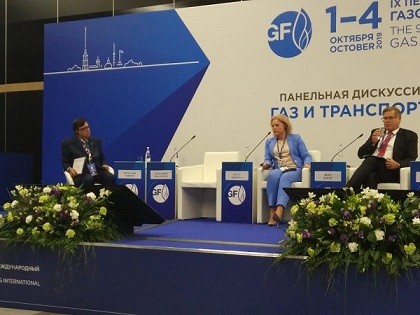 Between 2021 and 2030, Gazpromneft Marine Bunker is going to put into operation three LNG bunkering ships in the North-Western region, IAA PortNews correspondent cites Elena Skoryna, Deputy General Director, Development, Gazpromneft Marine Bunker, as saying at the 9th St. Petersburg International Gas Forum.
Between 2021 and 2030, Gazpromneft Marine Bunker is going to put into operation three LNG bunkering ships in the North-Western region, IAA PortNews correspondent cites Elena Skoryna, Deputy General Director, Development, Gazpromneft Marine Bunker, as saying at the 9th St. Petersburg International Gas Forum.
According to the speaker, the first LNG tanker of 5,800 cbm in capacity is already under construction with its commercial operation to begin in Q2’2021. Two more LNG bunkering ships are to be put into operation later, by the year of 2030.
According to Elena Skoryna, the company, together with Gazprom, has been suggesting development of national regulations on LNG bunkering for the recent three years.
“A comprehensive approach is needed for the development of this promising market and we pursue it”, - she said.
Gazpromneft Marine Bunker, a subsidiary of Gazprom Neft, was established in 2007 to provide year-round supplies of marine fuel and oils for sea and river vessels. Gazpromneft Marine Bunker currently has eight regional offices and six subsidiary companies. Gazpromneft Marine Bunker operates in main sea ports of Russia.



